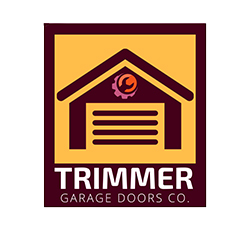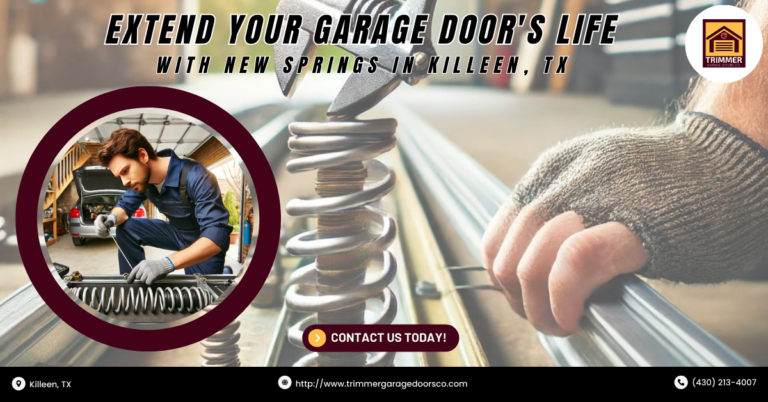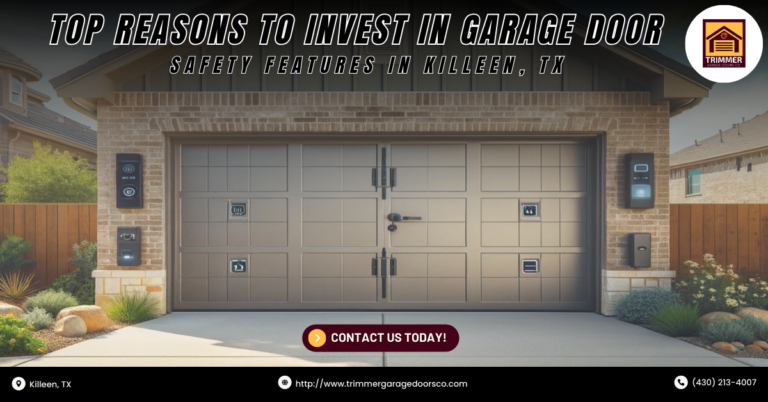Explore the world of garage door springs with Trimmer Garage Doors Co.’s comprehensive guide. Learn about torsion springs, extension springs, and more. Serving Killeen, TX, and surrounding areas.

Unveiling the Mysteries of Garage Door Springs
Welcome to our exclusive guide to understanding the intricate world of garage door springs. If you’ve ever wondered what makes your garage door smoothly glide open and close, you’re in for a treat! But first, let me introduce ourselves. Trimmer Garage Doors Co. is your go-to destination for all things garage doors in Killeen, TX. Whether it’s repair, installation, or emergency services, we’ve got you covered. Now, let’s dive into the fascinating realm of garage door springs!
The Basics: What Are Garage Door Springs?
Ah, the unsung heroes of the garage – garage door springs! Now, I know what you might be thinking, “What’s the big deal about these little coils?” Well, let me tell you, they’re the reason you’re not playing tug-of-war with your garage door every time you want to leave the house. Garage door springs are essentially the muscles of your garage door system. They work tirelessly behind the scenes to counterbalance the weight of the door, making it feel as light as a feather when you lift it.
Imagine this: without garage door springs, you’d be facing a Herculean task every time you wanted to open or close your garage door. Picture yourself heaving and hoisting, straining with all your might just to get the door to budge. Not exactly a pleasant thought, is it? That’s where garage door springs swoop in to save the day. By storing and releasing energy as the door moves, these trusty springs make your life a whole lot easier. So, the next time you effortlessly glide your car in and out of the garage, take a moment to thank those humble coils silently working away above your head.
The Two Main Types: Torsion Springs vs. Extension Springs
Now that we’ve established the crucial role that garage door springs play, let’s dive into the nitty-gritty details. You see, not all springs are created equal. When it comes to garage doors, there are two main types: torsion springs and extension springs. Each type has its own unique characteristics and benefits, so it’s essential to understand the differences between them.
Torsion Springs: The Powerhouses of Garage Doors
Imagine a coil of steel quietly sitting above your garage door, waiting patiently to spring into action (pun intended). That’s essentially what a torsion spring does. These heavy-duty springs are typically mounted horizontally above the door, and they pack quite a punch when it comes to lifting power. As the door opens or closes, the torsion spring twists and unwinds, storing and releasing energy to keep everything in perfect balance.
One of the main advantages of torsion springs is their durability. These bad boys are built to last, capable of withstanding thousands upon thousands of cycles without breaking a sweat. Plus, since they’re mounted above the door, they’re less exposed to the elements, which means they’re less likely to rust or wear out prematurely. So, if you’re looking for a reliable, long-lasting option for your garage door, torsion springs are definitely worth considering.
Extension Springs: The Underdogs of Garage Door Springs
Now, let’s shine the spotlight on extension springs, the unsung heroes of the garage door world. Unlike their torsion counterparts, extension springs are typically mounted on either side of the door, running parallel to the horizontal tracks. When the door opens, these springs extend and contract, providing the necessary tension to support the weight of the door.
While extension springs may not have the same heavyweight reputation as torsion springs, they’re still essential components of your garage door system. They offer reliable support and balance, ensuring that your door operates smoothly and safely. Plus, since they’re mounted on the sides of the door, they’re often easier to access and replace, which can be a plus when it comes to maintenance.
In summary, both torsion springs and extension springs play vital roles in keeping your garage door in tip-top shape. Whether you opt for the powerhouse performance of torsion springs or the dependable simplicity of extension springs, you can rest assured knowing that your garage door is in good hands.
Signs of Trouble: How to Spot a Failing Spring
Now, let’s talk about something crucial: how to tell if your garage door springs are giving you trouble. After all, prevention is key when it comes to avoiding costly repairs and potential safety hazards. So, keep your eyes peeled for these telltale signs that your springs might be on the fritz:
- Sudden Jerky Movements: If your garage door starts moving in a jerky, uneven manner, it could be a sign that one of your springs is failing. As the spring loses its tension, it may struggle to support the weight of the door, causing it to lurch and stutter as it opens or closes.
- Visible Wear and Tear: Take a close look at your garage door springs. Do you see any signs of wear and tear, such as rust, corrosion, or fraying? These are all indicators that your springs may be nearing the end of their lifespan and could be at risk of breaking.
- Loud Bangs or Snaps: A loud bang or snap when you open or close your garage door is never a good sign. This could mean that one of your springs has suddenly broken under the strain, which can be both dangerous and damaging to your door and opener.
- Difficulty Opening or Closing: If you find yourself straining to open or close your garage door, it’s possible that your springs are to blame. As the springs lose their tension, they become less effective at counterbalancing the weight of the door, making it feel heavier and more difficult to operate.
- Gaps or Gaps in Movement: Finally, keep an eye out for any gaps or gaps in movement as your garage door operates. If you notice that the door hesitates or stalls at certain points during its cycle, it could indicate that one of your springs is failing to provide the necessary tension.
If you observe any of these warning signs, it’s essential to address the issue promptly to prevent further damage and ensure the safety of your garage door system. Don’t wait until it’s too late – contact a professional garage door technician to inspect your springs and make any necessary repairs or replacements. Remember, when it comes to garage door springs, it’s always better to be safe than sorry!
DIY vs. Professional Repair: What You Need to Know
Alright, so your garage door springs are acting up, and you’re faced with a dilemma: should you roll up your sleeves and attempt a DIY repair, or should you leave it to the pros? It’s a valid question and one that many homeowners grapple with. Let’s break it down:
The Appeal of DIY Repair:
There’s something undeniably satisfying about tackling a home repair project yourself. It’s a chance to flex your DIY muscles, save some money, and maybe even learn a thing or two along the way. Plus, with the wealth of tutorials and guides available online, it’s easier than ever to find step-by-step instructions for fixing just about anything – including garage door springs.
The Risks of Going DIY:
However, before you break out the toolbox, it’s essential to recognize the risks involved with DIY garage door spring repair. First and foremost, working with garage door springs can be dangerous – like, seriously dangerous. These springs are under a tremendous amount of tension, and if mishandled, they can cause serious injury or even death. Plus, if you don’t have the proper tools or expertise, you could end up causing further damage to your door or opener, leading to even costlier repairs down the line.
Why Trust the Pros:
That’s where professional garage door technicians come in. These folks eat, sleep, and breathe garage doors, and they’ve seen it all when it comes to spring repairs. They have the knowledge, experience, and specialized tools needed to safely and effectively repair or replace your springs, ensuring that your door operates smoothly and safely. Plus, most reputable garage door companies offer warranties on their work, giving you added peace of mind knowing that your repair is covered.
The Importance of Regular Maintenance
Alright, folks, listen up – we’re about to drop some knowledge bombs about the importance of regular maintenance for your garage door springs. Now, I know what you’re thinking: “Maintenance? Ain’t nobody got time for that!” But trust me when I say that a little TLC goes a long way when it comes to keeping your garage door springs in tip-top shape.
Why Maintenance Matters:
Here’s the deal: garage door springs may be small, but they sure do a lot of heavy lifting (pun intended). And just like any other mechanical component, they need a little love and attention from time to time to keep them operating smoothly. Regular maintenance can help catch any potential issues early on, preventing costly repairs down the line. Plus, it can help extend the lifespan of your springs, saving you money in the long run.
Simple Maintenance Tips:
So, what does garage door spring maintenance entail, you ask? It’s pretty straightforward. Start by visually inspecting your springs for any signs of wear and tear, such as rust, corrosion, or fraying. Next, lubricate the springs and other moving parts with a silicone-based lubricant to keep everything running smoothly. Finally, test the balance and tension of your springs regularly to ensure they’re operating within the manufacturer’s specifications.
Choosing the Right Springs for Your Garage Door
Now that you understand the importance of maintenance let’s talk about choosing the right springs for your garage door. You see, not all springs are created equal, and selecting the right ones can make a world of difference in terms of performance and longevity.
Factors to Consider:
When it comes to choosing garage door springs, there are a few key factors to keep in mind. First and foremost, you’ll need to consider the size and weight of your garage door. Larger, heavier doors will require stronger springs to provide adequate support and balance. Additionally, you’ll want to think about how often you use your garage door. If you’re constantly opening and closing it, you’ll need springs that can handle the extra wear and tear.
Trust the Experts: Why Trimmer Garage Doors Co. Is Your Best Bet
When it comes to garage door repair in Killeen, TX, you need a team you can trust. Trimmer Garage Doors Co. has been serving the community for years, providing top-notch service and unparalleled expertise. From residential garage door repair to commercial installations, we do it all with precision and professionalism.
Conclusion: Secure Your Garage Door’s Future with Trimmer Garage Doors Co.
In conclusion, understanding the different types of garage door springs is essential for maintaining a safe and functional garage door system. Whether you’re dealing with torsion springs or extension springs, knowing how they work and when to seek professional help can save you time, money, and headaches in the long run. When it comes to expert garage door services in Killeen, TX, Trimmer Garage Doors Co. is the name to trust. Contact us today for all your garage door installation, residential garage door repair, commercial garage door repair, and emergency garage door repair needs in Killeen, TX, including areas near Fort Hood and Lions Club Park.






